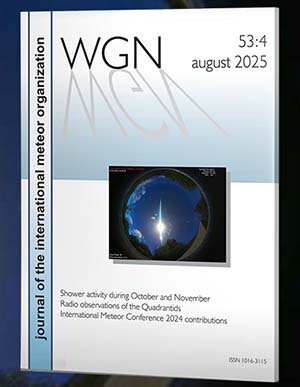September offers longer nights and cooler
temperatures in the northern hemisphere. In the sky, no major showers are visible
from either hemisphere but the northern hemisphere enjoys the advantage of higher
sporadic rates. The two recognized minor showers active in early September have
high northern declinations (celestial latitude) therefore are much better suited
to be viewed from locations north of the equator. During the second half of the
month the antihelion radiant becomes entangled with the two Taurid radiants and
it is impossible to separate them. Therefore the antihelion radiant will be excluded
from the list from the second half of September until the end of the Taurid activity
period late in November. Observers in the southern hemisphere suffer from some of
their lowest rates of the year this month. The Taurid radiants are not too badly
placed so observers south of the equator can expect to see a little of this activity
toward the end of the month.
During this period the moon wanes from its full
phase to nearly half illuminated by the 11th. This weekend the nearly full moon
will be in the sky the entire night, making meteor observing difficult at best.
As the week progresses the moon will rise later in the evening with each passing
night but will still interfere with the prime morning observing hours. The estimated
total hourly rates for evening observers this week is near four as seen from the
northern hemisphere and one from the southern hemisphere. For morning observers the
estimated total hourly rates should be near six from the northern hemisphere and
two as seen from the southern hemisphere. The actual rates will also depend
on factors such as personal light and motion perception, local weather conditions,
alertness and experience in watching meteor activity. Meteor rates are greatly
reduced by moonlight all this week.
The radiant positions and rates listed below are exact
for Saturday night/Sunday morning September 5/6. These positions do not change
greatly day to day so the listed coordinates may be used during this entire period.
Most star atlases (available at science stores and planetariums) will provide maps
with grid lines of the celestial coordinates so that you may find out exactly
where these positions are located in the sky. A planisphere or computer planetarium
program is also useful in showing the sky at any time of night on any date of the
year. Activity from each radiant is best seen when it is positioned highest in the
sky, either due north or south along the meridian, depending on your latitude. It
must be remembered that meteor activity is rarely seen at the radiant position.
Rather they shoot outwards from the radiant so it is best to center your field of
view so that the radiant lies at the edge and not the center. Viewing there will
allow you to easily trace the path of each meteor back to the radiant (if it is
a shower member) or in another direction if it is a sporadic. Meteor activity is
not seen from radiants that are located below the horizon. The positions below
are listed in a west to east manner in order of right ascension (celestial longitude).
The positions listed first are located further west therefore are accessible earlier
in the night while those listed further down the list rise later in the night.
The full descriptions of each active meteor shower will continue next week when
the moon becomes less of a nuisance to observers.
The table below presents a condensed version of the expected activity this week.
Rates and positions are exact for Saturday night/Sunday morning.
| SHOWER | DATE OF MAXIMUM ACTIVITY | CELESTIAL POSITION | ENTRY VELOCITY | CULMINATION | HOURLY RATE | CLASS* | RA (RA in Deg.) DEC | Km/Sec | Local Daylight Time | North-South | Antihelions (ANT) | – | 23:44 (356.0) -01 | 30 | 02:00 | 2 – 2 | II | September Iota Cassiopeiids (SIC) | Sep 11 | 02:24 (036.0) +60 | 50 | 04:00 | <1 - <1 | IV | September Epsilon Perseids (SPE) | Sep 09 | 03:00 (045.0) +41 | 66 | 05:00 | <1 - <1 | II | Nu Eridanids (NUE) | Sep 06 | 04:27 (066.7) -01 | 68 | 06:00 | <1 - <1 | IV |




 You saw something bright and fast? Like a huge shooting star? Report it: it may be a fireball.
You saw something bright and fast? Like a huge shooting star? Report it: it may be a fireball.  You counted meteors last night? Share your results with us!
You counted meteors last night? Share your results with us!  You took a photo of a meteor or fireball? You have a screenshot of your cam? Share it with us!
You took a photo of a meteor or fireball? You have a screenshot of your cam? Share it with us!  You caught a meteor or fireball on video? Share your video with us!
You caught a meteor or fireball on video? Share your video with us!